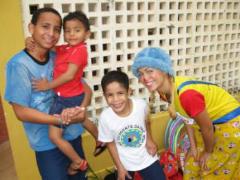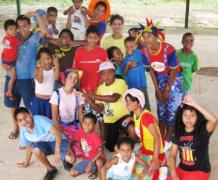In this planned city, accommodation for the poorer sectors of society was not part of the grand design

BrasÃlia is the capital of Brazil and has a population of about 2.5 million, making it the fourth largest city in Brazil. Brasilia is a planned city built just over 50 years ago by the architect Oscar Niemeyer in the remote central-west region of the country in a tropical savannah climate. Its isolation caused problems for the city from the start, e.g. high rates of corruption at all levels took place there, far from the public eye. The construction workers who built the city came mainly from poor north-eastern regions of Brazil, and they stayed on in Brasilia after building work was completed, living in makeshift settlements on the peripheries of the city. Today, millions of people live in these satellite towns – more than in the capital itself.
To this day, inequality in Brasilia remains extremely pronounced
The central area of the city is impressive due to its unique architecture and grand government buildings, but life in the Brasilia metropolitan area is a completely different story. In the satellite towns living conditions are often very poor. Houses are built from inadequate materials, are often illegally occupied and, to make matters worse, they are small and overcrowded, leading to conflict within the family.
In many households, it is the norm that the father goes out to work while the mother stays at home and cares for the children. This single income is often not sufficient, but due to the limited availability of early childhood care in the area, it is impossible for mothers to contribute to the family’s income, even by working part-time.
Rates of alcoholism or drug abuse amongst parents are high, as are incidents of domestic violence, which often creates a vicious cycle where children and young people fall into substance abuse too, as a way of dealing with their difficult family situation. This, in turn, makes them incredibly vulnerable to sexual exploitation or child labour. In the worst cases, these children may be abandoned by their parents entirely, or may even flee their home and choose a life on the streets instead.
What we do in Brasilia

SOS Children’s Villages began its work in Brasilia in 1968.
Strengthening families: The SOS Family Strengthening Programme provides much needed support to families who are at risk of breaking down. We aim to reach out to those who are especially vulnerable. We ensure that they have access to services and that children go to school. We also run a community centre which offers workshops (for example on children's rights), training (for parents to make some income) and activities (such as sport lessons and theatre performances).
Care in families: For children in BrasÃlia who are no longer able to live with their parents, three SOS families can provide a loving home. One SOS family lives in housing integrated into the community. In each family, the children live with their brothers and sisters, affectionately cared for by their SOS mothers. As the children grow older, we give them training and advice so that they can find a job.